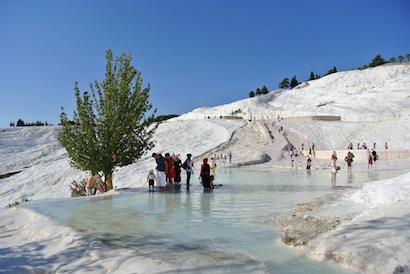Pamukkale Information
Worldly famous Pamukkale, also called ‘cotton castle’, is located at the southern banks of the Hierapolis Ancient City in Turkey. Since thousand of years, the water got colder and solid as it got farer from the calcareous hot water source and formed the travertine terraces in the shape of floors and steps. There is “radon gas” in Pamukkale Travertine and this gas has a relaxing effect for people. Besides being a unique natural phenomenon, Pamukkale Travertine can be used for healing purposes as hot springs.

Pamukkale and Hierapolis together are both recognized as UNESCO World Heritage Sites since 1988. They have all the conditions required for an ideal touristic resort. Pamukkale is very well known with the entrancing beauty of its unique geological formation and also with its historical remains. Entrance information can be found here.
Formation of Pamukkale
The white cotton-like terraces are mineral deposits which come from Cal Mountain’s rich spring waters and volcanic springs that were saved since thousand years. The water runs down the travertine and fill them up with water and there is a pool where you can have a chance to swim among the ancient Roman columns. The ancient city of Hierapolis was located on the top of the white terraces and is about 2700 meters long and 160m high. It can be seen from the hills on the opposite side of the valley. It has 14000 year-old existence.
Pamukkale travertine is a type of limestone deposited at the mouth of the spring. Thermal sources on an important fault line of western Anatolia in Pamukkale are warmed up by subterranean heat and come out at 33-36 C. The water contains calcium hydro carbonate. Tectonic movements triggered frequent earthquakes in this area and gave rise to the emergence of a number of very hot springs. The water from these springs created Pamukkale with its large mineral content. When the hot water is in touch with the carbon dioxide, it starts to lose its warmth and also the carbon dioxide and carbon monoxide are released in to the air. As a result the calcium carbonate is precipitated. So the water forms magnificent viewed travertine.
There is a high amount of calcium and carbon dioxide in the combination of the water. Water channels carry water which comes out of the ground arrives to the terraces. But before water channels were built, water used to reach travertine by natural channels formed by running warm water. Because of the calcium in water, objects such as branch of a tree or a stone piece left in the flowing water are whitened in a short time.
Pamukkale pictures and videos
Watch Pamukkale pictures / photos and videos taken on the Media page.
